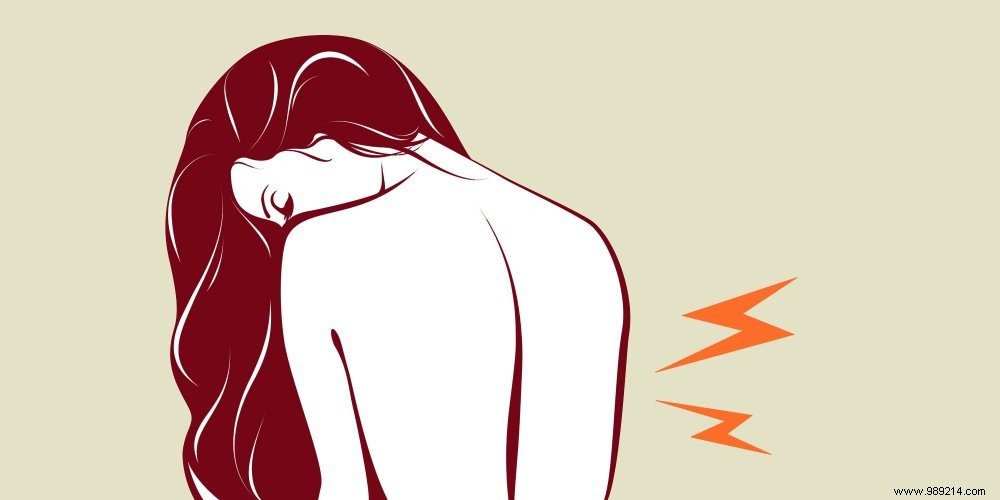 Also known as "lower back", lumbago is a sharp pain that is located in the lower back. This is one of the first reasons for consultation with the general practitioner. Better to stem it quickly, before it becomes chronic.
Also known as "lower back", lumbago is a sharp pain that is located in the lower back. This is one of the first reasons for consultation with the general practitioner. Better to stem it quickly, before it becomes chronic. 47% of French people today say they have regular back pain, compared to 30% 30 years ago. Between permanent stress, sedentary lifestyle and our days in a seated position, the scourge is spreading at full speed.
Indeed, we spend 80% of the time with our posterior screwed on a seat , which shifts the center of gravity of the body and upsets the balance of muscle chains. Some muscles, like the glutes, work less than they should. And others, like the paravertebrals, are used excessively . In addition, "the seated position tends to erase the lumbar curvature of the spine, explains Professor Jean-Jacques Le Huec, head of the orthopedic-traumatology department at the Bordeaux University Hospital. By force, the discs are crushed and tensions appear in the lower back".
The first instinct is often to relieve the pain with anti-inflammatories and analgesics. But as pointed out by a study from the University of Sydney (Australia), published in the journal British Medical Journal , paracetamol provides limited help:this drug is no more effective than a simple placebo. And other painkillers (ibuprofen, Voltaren, etc.) present cardiovascular risks during long-term consumption.
When the pain is very intense, morphine brings notable relief. "But it camouflages the pain and does not treat the cause, notes Dr. Isabelle Negre, head of the pain center at Bicêtre Hospital. The best thing is to reduce medication and use complementary therapeutic approaches in synergy".
Video of the day:These manual techniques give good results in case of lumbago. The more recent the pain, the more it will yield with manipulations. Consult immediately after the acute phase for optimal results.
The compilation of several studies carried out in 2017, published in the Journal of American Medical Association , proves it:"spinal adjustments reduce pain by about 10 points on a scale of 100 and improve mobility in people with low back pain" , notes Caroline Lambert, vice-president of the French Chiropractic Association (AFC).
If the pain is severe, rest your back for 24 to 48 hours at most. But then you have to move. Contrary to popular belief, prolonged bed rest aggravates pain , increases stiffness and reduces muscle tone, which sets up a veritable vicious circle. "It is better to keep a normal physical activity as long as the pain is bearable", assures Marianne Estève, physiotherapist at the Thermes d'Aix-les-Bains.
But don't just make any move. You have to save your back by avoiding carrying loads (basket or heavy file) at arm's length. “Hold them as close to the body as possible, advises Caroline Lambert. Standing up, do not keep the same position for too long:put one foot on a step or a low stool. And in a seated position, protect your lower back by sitting close to the edge of the chair, feet flat on the floor and shoulders relaxed".
Transcutaneous Electrical Neurostimulation defuse the pain. It short-circuits the transmission of nerve messages to the brain and stimulates the release of endorphin, a natural painkiller. For mild to moderate low back pain, electrotherapy patches based on this principle are now available in pharmacies (Urgo Patch). And for severe and stubborn low back pain, an implantable neurostimulation device has just arrived in France. Called ReActiv8, it consists of a mini-box equipped with two electrodes that a surgeon inserts on each side of the spine. An external remote control activates the box to generate electrical impulses when pain occurs.
PCP Therapy – or Continuous Deep Pressure – can also permanently unlock. This method consists of exerting strong pressure (from 1.5 to 20 kg) on the deep postural muscles in order to release the stiffened muscles, ligaments and tendons. The skeleton then repositions itself naturally and the repeated lumbago disappears. Five to six sessions with the physiotherapist are often enough to overcome stubborn low back pain.
Read also: